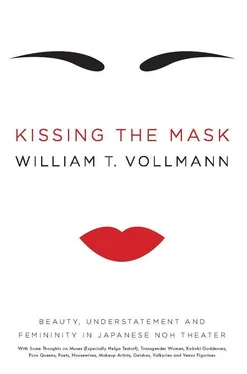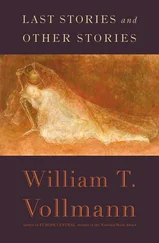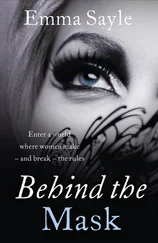The wife of “Kinuta” stands in her brocaded splendor, uttering her sadness in a deep, musical male voice, chanting her own dying while the flute inhumanly, neutrally trills. The dull blows of the fulling block sound her dirge. She raises her hands to her face, meaning that she’s crying; she’s just learned that her husband will be away for another year; while the maidservant hovers eerily, half-smiling behind her; and later the striped curtain at the far end of the bridge will rise of its own accord as the sad woman glides out from behind it; she’s died of anguish; she’s a ghost now. Her hands clasp one another at the breast; her perfect face whitely gleams, peering and half-smiling as she impels herself toward the stage, slowly swiveling toward us the fan tucked into the breast of her kimono. And her smile, her smile—
These masks are the Umewaka family’s richest treasures. Certainly, their loveliness is almost indescribable.
CLASSICAL BEAUTIES
The apprentice lays before me the mask of a young girl, most likely fifteen or sixteen, and a virgin. (Had she borne a child, a different mask would be required.) How strange I feel to see it in isolation from a dancer’s rigid body, and likewise lacking both a splendid kimono and that spill of jet-black horsehair! It’s called a ko-omote , a little mask, “little” referring to the age of the girl it portrays (she may be as young as thirteeen); and it’s so real, so well-fashioned that it could almost be a real girl’s decapitated head, except that it’s not dead, nor gruesome; it could come alive at any instant. In a moment he’ll show me a waka-onna , which is the mask of a woman who’s a decade older and remains childless. Just as the kimonos for young women’s roles all contain at least a splash of red, so these young women’s masks have their teeth fashionably blackened in the style of classical Japanese beauties 14— and, by the way, it is a wonder how these teeth, whose presence is in many cases not much more than hinted at between the half-smiling lips, glisten so translucently, as if each girl were truly alive and had just this second run her tongue across them. These masks also bear peculiarly high eyebrows, because in the Heian era (794–1185), aristocrats of both sexes depilated themselves there and painted surrogates far up upon their foreheads. It’s said, although the apprentice disbelieves it, that these masks before me are five hundred years old. Two-thirds of the ones in the Umewaka family collection do come from the Edo period at least, so this sixteen-year-old girl, if she ever existed in life, has long since been dust. After her, dynasties burned out; the moat of Nagoya Castle is choked with grass — and within a few steps of it stands a Noh theater for Mr. Umewaka to perform in, acting out another dance of transience: “Late dewdrops are our lives.” Since Noh is about karma and transience, how fitting it is that these ancient roles, these ancient beautiful faces, get brought to life by successive generations of actors who themselves become dust!
Once upon a time, in the long gone Muromachi centuries before Noh had become quite so codified, biological women did sometimes play Noh. I wonder what they looked like? Do these masks represent them? I remember a photograph of the mask called “Flower.” I have gazed at an image of the mask called “Snow.” I once saw a picture of the mask called “Moon.” Thus the Three Treasures referred to by Edo mask makers as ideals for ko-omotes . In their teeth and eyebrows, in their bottom-heavy plumpness, too, these ladies do not in the least resemble the Japanese women of today. Every aspect of Noh is so antediluvian! Zeami writes that it is “really easy” for the Noh actor to “play the part of an ordinary woman… as he is accustomed to seeing them.” I admit that on the train back from Yokohama, where I’d gone to study the exhibition of a renowned carver who’d faithfully copied her masks from six-hundred-year-old originals (Mr. Umewaka, who recommended her to me, had twice awarded her second place in the national competitions), I did finally see one woman whose face resembled a Noh mask: broad, flat, glossy, with sunken, upcurving eyes (she lacked the high-painted eyebrows, however), small and darkish teeth, a lower lip which protruded just as all the masks’ did — so what? Miss Tosaka plays the part of a pretty lady of the twenty-first century. Mr. Umewaka can become a beauty of half a millennium ago — or should I say a beauty who never existed? 15
The best masks have been carved, very appropriately, from the endangered Kiso cypress, 16a honey-colored, close-grained wood of middle weight whose scent resembles cardamom. Only about thirty professional Noh carvers continue the craft in Japan, and of course they all follow the same method, or what they have reconstructed of that method (during the Meiji Restoration, when Noh fell into decline, some details of this process were lost): smoothing and whitening the chiseled blankness of the newborn face with a mixture of hide glue and powdered oyster-shell — and, needless to say, this being Noh, several subtle finenesses of oyster-shell get employed in their season, these ranging in granularity from the coarseness of talcum powder to the silkiness of confectioner’s sugar. As for the hide glue, that also comes in various grades, from a greenish-grey sheet resembling kelp (this was never used by the mask maker who brought me into his workroom in the mountain tea-fields overlooking Shimada; he considered the greenish sheets to be entirely inadequate) to higher-quality sticks of a dark amber, to candylike rods of a lighter amber, to astonishingly transparent honey-colored fragments which derive from deer and are purer and clearer than any of the various equivalents I myself have ever been able to find. The second-best glue, the kind which comes in slender rods, generally suffices at this stage. The mask maker showing these items (his name was Mr. Otsuka Ryoji) told me that if his carving has been exceptionally good, he can get by with five undercoats; often he requires as many as eight. I wish that you could see him there amidst his own beautifully handmade compasses and calipers of different woods, each tool lovingly stained; they sometimes resemble lobster-claws with blond spicules inset in their polished jaws; it takes him longer to fabricate them than it does the masks themselves. He sits there in a niche of his own design between the chisel-cabinet and the carving-bench, trying to work as slowly and quietly as possible, to control his breathing as he works, to be surrounded by the same natural sounds which the ancient carvers heard. It is in the individual painted hair-strands of his competitors’ masks that he so often discovers the blemishes of haste. Try to see him there, carving and then ever so carefully undercoating. Compared to Mr. Umewaka, although far less so than I, he’s infected with the disease of self-assertion; he likes to make fanciful mosquito masks, catfish masks, masks of modern Japanese faces; but what he possesses, what every artist must have to some degree, and anyone affiliated with Noh requires to the nth degree, is painstakingness. In the heart of the triple-storeyed Umewaka family theater, which gazes down on its Japanese maples, keeps pace with its magnolias, and finds itself overshadowed by the apartment buildings whose flags are laundry hanging from their balconies, there is a darkened stage where Umewaka Rokuro sings in faraway resonance while his four-year-old granddaughter eagerly dances out a rudimentary pattern-square beside him, raising her fan when he does, lowering it, kneeling, coming and going at his word, his fan and her fan glistening; he chants, and she bustles obediently back and forth, kneeling, raising her fan, gazing at him adoringly. Once he was obliged to learn; now he must teach, lesson after lesson; fixing within the child the unalterable core of each gesture and position, so that Noh will live another generation, and the woman in the pale yellow kimono can once more outstretch her partially closed fan, her superbly, inexhaustibly beautiful face offering itself to the eye forever. As for Mr. Otsuka, in place of lessons, performances and exercises (although he encounters all those), he mainly confronts undercoats. Each layer must contain less hide glue than the one underneath, in order to avoid future cracking. Now for the outermost beauty itself. The basic color palette for a Noh mask is red, green and brownish-yellow, although, like the simplifications “hide glue” and “oyster-shell,” this cannot do justice to the arrays of pigments in their labeled packets. Mr. Otsuka claims, and I lack the means to evaluate this, that the Japanese language possesses more words for color-shades than any other tongue; but I do see before me three different hues of, for instance, blood-red cinnabar. For the skin-tones of a Noh mask, a greenish-yellow mixed with fiery orange goes on first, this being lightened with layer after layer of glue and oyster-shell. I have read that these same whitened mercury pigments were used for both men’s and women’s cosmetics in the Heian era; Genji himself was known as “The Shining Prince” not only thanks to his charisma but also on account of his white complexion. How faithfully the Noh masks duplicate that makeup I doubt that anybody knows. At any rate, by this stage only the supreme grade of glue can be employed. “You use nice color,” said Mr. Otsuka, “and then on top of it you put something else to make it look more subdued, so it doesn’t look too shallow. After fifty or a hundred years, if you’ve used something unsubtle, it’s really going to show; it’ll start looking worse and worse.” He applies a minimum of three such overcoats. Then come the eyes, the hair, the lips… Let’s mention only the second of these. The lips of the ko-omote are colored with an orangish kind of cinnabar which he’s enriched with one of its mid-scarlet cousins; next comes the glaze, which at the very end he partially removes, in order to bring out maximum brilliancy. The lips of his old-woman masks must be darker than those of the young girls. Every aspect of the making, in short, is flavored with distinctions and subdistinctions, guided by care, love, and skilled restraint. The most difficult part, he says, is “to have a clear image of the look and shape in my brain. First the mask forms in my mind. The physical work is relatively easy.”
Читать дальше












